SHIP ARRIVING TOO LATE TO SAVE A DROWNING WITCH: THE MODERN ROCK BAND
At the same time as Zappa was busy preparing the recording of his orchestral scores, he was more than ever behaving as the conductor of his rock band on tour, giving highstanding and technically impressive performances. Some of the orchestral pieces also found their way on the rock albums from this period, the "Drowning witch" album (1982) including "Envelopes", "You are what you is" and "Them or us" (1984) both including sections from "Sinister footwear". The latter composition hasn't been recorded yet in its orchestral form, but the scores are available at Barfko Swill. The subject of this section is continued in the Them or us section.
1. No not now
"Ship arriving too late to save a drowning witch" begins with two normal popsongs and then proceeds with
an awe-inspiring combination of Zappa's composing skills and improvising capacities on guitar.
Zappa would re-use "No not now" for his "Thing-Fish" opera from 1984. It has the same
tracks with overdubbed spoken texts. In "Thing-Fish" the "No not now" track is included in combination with a version played backwards.
The latter rendition has also the title written backwards: "Won ton on".
Both songs are being dealt with in the Thing-Fish section of this study.
Regarding its lyrics "No not now" got a sequel with "Truck driver divorce" from "Them or us".
Though the word truck is never used during "No not now", its lyrics are full of allusions to the southern truck drivers world, especially
truck drivers restaurants:
- Truck: transcontinental hobby horse.
- Clothing: big old hat, cowboy pants.
- Truck drivers restaurant: the waitress, Hawaiian lunch, ride the bull.
- The cargo and destination: string beans to Utah.
2. Valley girl
Next are regular and unorthodox rock 'n roll, following upon each other on the album. The first is "Valley girl", a piece
for which Zappa's daughter Moon suggested the lyrics. Frank took the bait. It has two short rock themes and a vamp, over which
Moon is doing her Encino accent.
Valley girl, opening (midi file).
Valley girl, opening (transcription).
Moon took an acetate to a radio station and it got that much attention, that it was
released as a single shortly after. It climbed up to number 32 in the billboard top 40, Zappa's only serious U.S. hitsingle.
It opens in C with the chord progression I-V-VI-V-III. Instead of giving a pedal note,
the bass is part of these chords. In bar 5 the music changes to F major/Lydian
with the progression F-C-G-Bb. Thus a progression of parallel major triads, causing
the B to turn up as both natural and flat. From bar 11 onwards the bass does
constitute a pedal note, with the key becoming E Phrygian. Here the accompaniment starts
vamping around the chord progression I-II-VI.
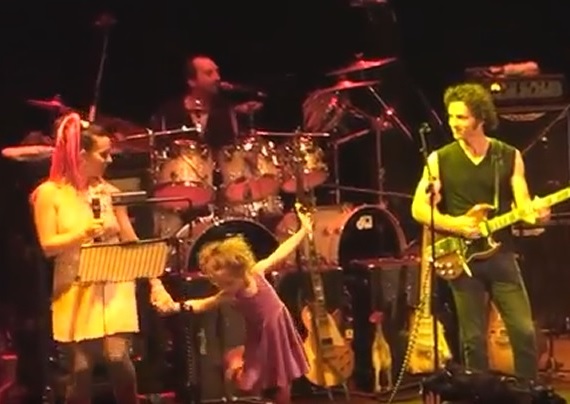
Moon with her daughter, singing "Valley girl" at one of Dweezil's "Zappa plays Zappa" concerts.
In Guitar Player, February 1983, page 99, Zappa commented:
"Hits are not necessarily musical phenomenons. But as far as my feeling about it goes, I think if that amuses
Americans, well, hey I'm an all-American boy. And I'm here to perform that function for you. Since that time,
we've hired a guy to make merchandising deals about that song. And you wouldn't believe what kind of things will be
coming out with the words "Valley girl" on them. You name it; everything from lunch boxes to cosmetics; including
a talking Valley Girl doll in February."
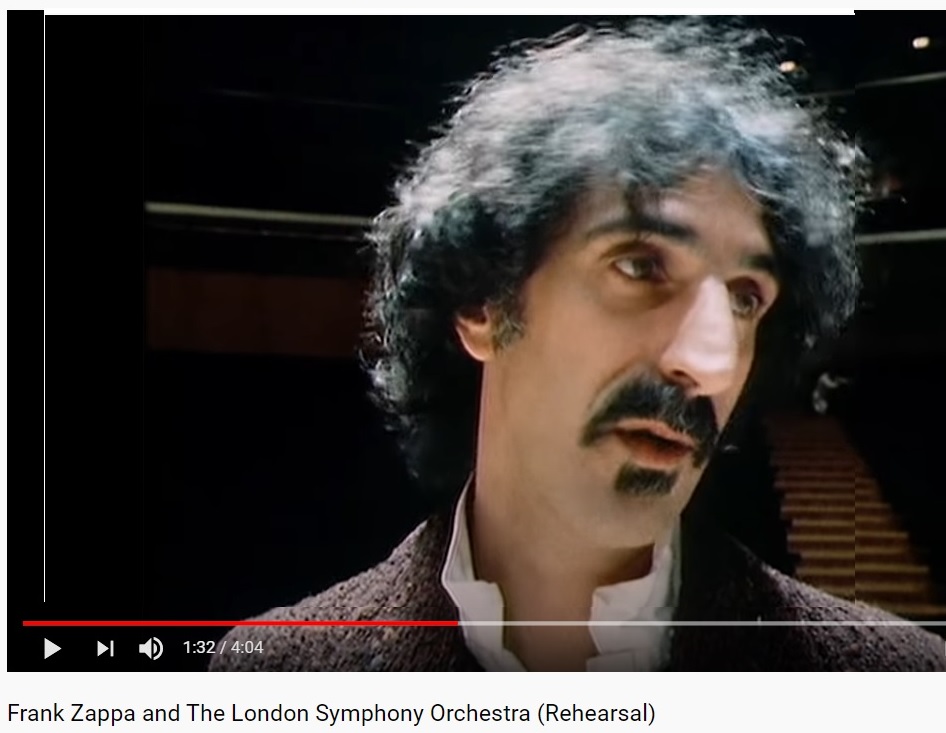
During the L.S.O. rehearsals Zappa got interviewed saying (https://www.youtube.com/watch?v=HA9XrWpLalw):
"I think it is just as serious to write a song like Valley girl as it to is write a ballet called Mo 'n Herbs vacation. To me they are equally
serious problems in music [...] In case of Valley girls it took me a matter of moments, but in some of the orchestra pieces
they'll take like six months to write, but doesn't mean there is any less seriousness involved in the construction of each piece, because they
are for different mediums, they are for different audiences, and they deal with different kinds of musical problems.
3. I come from nowhere
On the album liner notes Steve Vai gets credited for the playing of "impossible guitar parts". Vai
commented that Zappa would frequently come up with try-out scores to see if it was feasible for him
to do things on guitar that Zappa himself thought were impossible. Zappa himself in Guitar Player, February 1983,
confides to us: "What usually happens is this: if I put another guitarist on my album, I hire
that person because he can play things that I can't play. And if the music requires a certain type
of performance, and the composition is the real crux of the biscuit, then you don't want to be unfair
to the composition and play it yourself if you're going to play it wrong. So I get people who can do it.
It's not a matter of being lazy; if there's something on a given song that I think is in my
department, I'm going to play it. But if it's something that will be difficult or impossible for me to do, I'd just as soon get somebody who feels comfortable
with that style and have them do it." I can only take this for granted, I'm a lousy
pianist and I can't play guitar at all. I can only transcribe deducing things - like apparently it goes as
such or so -, but don't ask me to play it.
The other unconventional example of rock 'n roll is
the opening of "I come from nowhere", rhythmically differentiated and using an accentuated dissonant G sharp plus A.
Varying meters come along, normal 4/4 and some odd ones. The 27/16 bar is a
fast pattern breaking atonal movement, possibly an "impossible one" for Steve Vai.
The middle of the song contains
an unusual chromatic melody formation, sung over
counterpoint bass lines and an ongoing rhythm guitar. A strong guitar solo rounds of this piece.
It's embarrassing to see that some of his own fans didn't follow him during this time. Dominique Chevalier
concluded in "Viva Zappa" that "Ship arriving too late to save a drowning witch" was second rate and the 1982
Geneva concert, released on "You can't do that on stage anymore vol. V", was stopped just before its scheduled
ending because of things being thrown on stage.
I come from nowhere, opening (midi file).
I come from nowhere, opening (transcription).
The transcription covers the opening bars with:
- Bars 1-4: opening theme in F# Mixolydian, with the chord progression I-VII-I-II-IV in bars 1-2. Over the IV
chord, held in bar 2, the dissonant notes G# plus A natural are played. The subsequent meters are 5/4, 4/4, 5/4 and 2/4.
According to Zappa, Guitar Player, February 1983, page 99, this dissonant was created in the following manner:
GP: "On "I come from nowhere" there's a strong dissonance, like a minor second clashing in the first few bars. Is that a guitar?"
FZ: "That is a bunch of bass harmonies a half-step apart. He's [Arthur Barrow] playing what I think is a little three-part
harmonic chord."
So noted. The G#-A dissonance dominates, but there may have been more to it.
- Bar 5: an atonal bar in 27/16. First it's a series of six 16th notes, next a sequence of lower thirds, half-way doubled
with descant parallel notes. The movement comes at rest on the closing 5th chord.
- From bar 6 onwards the song becomes more normal rock 'n roll in B minor, mostly in 4/4, sometimes 2/4.
Bars 6-7 form a chord progression, Bm-A#m-E-Db-D, at this point still being kind of chromatic.
In bars 8-9 a two-bar vamp gets introduced, doing the chord sequence B-G-F#m7 in rock terms. Thus first two parallel major
chords with the D altered to D# for the first one (it's a bit ambiguous about its key being B Mixolydian or minor).
- In bar 20 the sung main melody begins over the vamp from bars 8-9. It's strongly syncopic and with its D always being natural, it can be dissonant with
the chords.
4. Ship arriving too late to save a drowning witch
The instrumental parts of the title track are an example of a composition made up of several motifs and
variation parts, played in different tempi as in "Debra kadabra" from the Bongo fury section. Other than
in the mostly unisono "Debra kadabra" track, the bass part in "Drowning witch" is frequently used for
counterpoint movements. The general outline is that this song is made up of six blocks:
Block I, with lyrics:
- 0:00-0:38: The opening theme is a two-bars motif, freely improvising around a melodic line. This line is E-G-A in the first bar,
followed by A-B-G in the second bar. The bass lick lasts one bar, giving an E pedal during beats 1-2, thus setting the key to E Dorian.
On beats 3-4 you've got a syncopic movement. The bass goes up to varying notes and back to E via G. The theme is played instrumentally
twice during bars 2-5 in the shape of a guitar chord series: I-III-IV, IV-I, I-III 7th-IV and IV-III-I. Bar 1 is a pick-up bar, with the first
chord probably stemming from the preceding song ("Drowning witch" is a compilation of various tracks, recorded live during the 1982 tour).
As for the lyrics you can see that they are sometimes speech influenced, sometimes musical. In bar 6 the words "ship" and "late" are on beat,
but the syllables from "ship arriving too" follow the exact rhythm of the spoken words. In bar 8 the opposite happens: "try", "keep", "date" and "with"
are ticking evenly. Here this goes to the disadvantage of the spoken words: the syllables "-ing to" from "trying to keep" get oppressed to the point that
they are hardly audible.
Drowning witch, opening bars (midi file).
Drowning witch, opening bars (transcription).
- 0:38-1:57. After the opening theme a through-composed block follows. It begins atonal and strongly speech-influenced. Not only the rhythm, but also the melody.
See the next The man from Utopia section for more on this topic. The bass and keyboard are improvising along with Zappa. The meter remains 4/4 from
the beginning of this song through bar 1 of the following example, with bass drum beats on beats 2 and 4. In bar 2 this gets interrupted for the first
time with a 3/4 bar with toms on beat 3. The main drum beats are included in the example, otherwise the meter notation would become inunderstandable.
In bars 5-8 you've got everything prescribed. The rhythm of bar 5 is remarkable: a 4/4 bar gets extended with one eight note to 9/8, this in combination
with a sextuplet over seven eight notes. Next the music continues in 4/4 again. The main chord progression in bars 6-8 is Fmaj7-Ab-G, making it sound diatonic again after a number
of atonal bars.
Drowning witch, 0:41 till 0:59 (midi file).
Drowning witch, 0:41 till 0:59 (transcription).
Block II, instrumentally:
1:57-3:12. This is the larger instrumental block from this song. It's a series of smaller themes and motifs. Next are three examples from this section.
It's abstract atonal music. With its smaller time units, the third example is being played in a thrilling high tempo, especially when the 16th notes occur. The first example deals with playing around the Ab note, varying the
rhythm within a 9/4 meter. The third one
contains various forms of sequences in bars 1-8, to end with deliberate irregular strings in bars 9-11. Combined with the high tempo and abstractness of the string
in bar 9, it's almost as if the band is firing notes at you with a machine gun.
Drowning witch, 2:30 till 2:38 (midi file).
Drowning witch, 2:38 till 2:44 (midi file).
Drowning witch, 2:47 till 3:03 (midi file).
Drowning witch, 2:30 till 2:38 (transcription).
Drowning witch, 2:38 till 2:44 (transcription).
Drowning witch, 2:47 till 3:03 (transcription).
In the booklet for "YCDTOSA vol. III" a second version of "Drowning witch" got included. Zappa comments: "This a hard song to play. How hard? The 1984 band never played it
correctly during the 6-months tour, and the 1982 band only managed to get close on one occasion. This edit collates the best efforts of both groups."
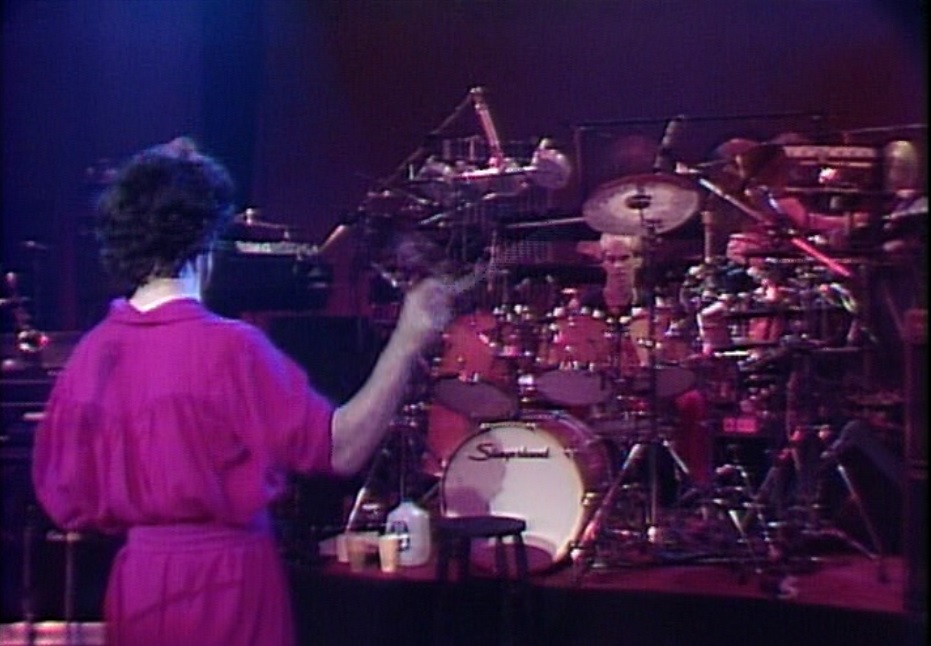
Zappa conducting his band in 1981 with Chad Wackerman in front of him (still from the Torture never stops DVD).
The difficulties of the song are getting clear from the examples
above. You have complex rhythmical figures as the sextuplet within a 9/8 meter and the section between 2:38 and 2:44. As noted by Elmar Luksch (see the links)
it contains a 9/8 bass figure, played as 4/4 extended with one eighth note. Over this a lead melody is played, that subdivides the 9/8 meter into 6, thus becoming
six beats lasting 3/16 each. The lead melody is also syncopically bound with the previous bar, so the effect you're getting is that the lead melody seems to float
over the bass figure without having a direct relationship with it. Only at one point per bar the bass and lead melody are equal. The upper lead melody is played in the shape
of three descending parallel fifths, in dissonance with the bass and middle part. Next you've got the mingling of tonal
and atonal music in this song, tempo changes and very fast episodes. The irregular strings must have needed time to memorize. At a detail level the "Drowning witch"
and "YCDTOSA vol. III" versions differ in many aspects, so even for a complex song like this, Zappa stuck to his habit of changing songs during tours.
The metronome tempos of a fourth note in the examples used
in this section are:
- Opening bars: 105.
- 0:41 till 0:59: 105.
- 2:30 till 2:38: 135.
- 2:38 till 2:44: 200.
- 2:47 till 3:03: 165.
- 4:40 till 4:52: 100.
- 11:07 till 11:17: 130.
The 1982 album
version is a highly edited compilation of tracks from the 1982 tour from a number of concerts. Zappa comments in Guitar Player, February 1983:
"Do you know how many edits there are in "Drowning witch"? Fifteen! That song is a basic track from 15 different cities. And some of the edits are like two
bars long. And they are written parts - all that fast stuff. It was very difficult for all the guys to play that correctly. Every once in a while,
somebody would hit the jackpot, but it's a very hard song to play. So there was not one perfect performance from any city. What I did is go through
a whole tour's worth of tape and listen to every version of it and grab every section that was reasonably correct, put together a basic track, and then [I]
added the rest of the orchestration to it in the studio."
Block III, first guitar solo:
3:12-6:45. This is a relatively unusual solo. The meter is 9/8 (subdivided as 2+2+2+3) and there's a lot of ambiguity about the tonic and scale used. The bass vamp has F and A competing
as pedal notes. During the intro it's played as the descending line F-F-E-D-A, setting the accent on F. When the soloing starts, the opening F is replaced by
a pause on the downbeat, so it sounds like the first beat becomes
syncopically bound with the A from the previous bar. So the A starts to function as tonic, more than the F. Towards the end the F returns as opening note.
In the "Drowning witch (1981)" example from the previous section, the F is maintained more clearly as the tonic.
As it comes to the scale a lot of chromaticism is going on.
The mostly used series are:
- A-B-C-D-E-F-G#: A minor (the common variant with a major 7th).
- A-B-C#-D-E-F-G# and A-Bb-C-D-E-F-G#: self-created scales, sort of Gypsy type scales with F-G# as an augmented second in it.
In the example below you have A-A# (Bb), G-G# and C-C# next to each other, showing the degree of chromaticism in this solo. In the background harmony
by the keyboards you always have a G# and the notes mostly used by the keyboard are the ones from the E7 chord, often as arpeggios.
The example begins with a dissonant feedback chord, howling softly.
Drowning witch, 4:40 till 4:52 (midi file).
Drowning witch, 4:40 till 4:52 (transcription).
Block IV, instrumental interlude:
6:46-7:14. A relatively short block, made up three smaller themes. The first is a melody over a chord progression, the second a string of unisono 16th notes.
The third is a guitar melody over an F# pedal.
Block V, second guitar solo:
7:14-11:06. Other than the first above, this one is more like a regular Zappa solo. It's stable in B Dorian and the meter is 12/8.
Drowning witch, 7:14-7:35 (midi file).
Drowning witch, 7:14-7:35 (transcription).
The example above contains the first four bars. In this study I'm using the transcriptions 1:1 to create midi files. In this case I had to use
three staves for the guitar part. The first represents the normal lead melody, the second less audible harmony notes and feedback and the third one
scratched notes, lightly audible in the background. Arpeggios, also the harmonic fill-in, are written out with their pace.
This may look a little odd on paper, but in this case I
really need things like this to let the midi file at least approach how it sounds on record.
Block VI, instrumental outro:
11:07-12:03. The following is a section from the outro. It's part of block with a chord sequence in a plain 3/4 waltz rhythm. The bars begin with one beat with quarter
notes evenly held,
followed by two lightly staccato beats. The bass is giving an F# pedal note and puts his own accents elsewhere occasionally, as on beat two in bar 3. The notes of the chords are played by different
instruments, spread out over the stereo field. For the chords Zappa is mingling three appearances of the minor type scale:
- F#-G#-A-B-C#-D-E: F# minor (Aeolian).
- F#-G#-A-B-C#-D-E#: F# minor (the standard variant with a major 7th).
- F#-G#-A-B-C#-D#-E: F# Dorian.
Drowning witch, 11:07 till 11:17 (midi file).
Drowning witch, 11:07 till 11:17 (transcription).
Over the F# pedal note, the chord progression in the example is:
- bar 1: E-A-E.
- bar 2: C#-Bsus2-F#m.
- bar 3: F#sus2-C#-Aaugm.
- bar 4: A-E-F#m.
- bar 5: Dmaj7-B-B.
- bar 6: C#-F#m-F#m.
If you would continue you would also get at a chromatic sequence in bar 13:
- bar 13: F#m-F-Asus2.
On the F chord the F and C once appear as natural in this section. Of the series F#m-F-Asus2, the A they have in common is held as the upper note and you've got a chromatically
descending fourth for the other two notes of the chords: C#+F# => C+F => B+E. In the next bar there's no such pattern. The transitions are kept fluid because
about all chords have notes in common with the previous chord, which is the norm for traditional harmony. Thus Zappa can do it this way, but he can also bluntly
jump from one chord from one scale to another chord from another scale without binding notes, like in "Uncle Meat" or "Would you like a snack".
- bar 14: B-D-C#.

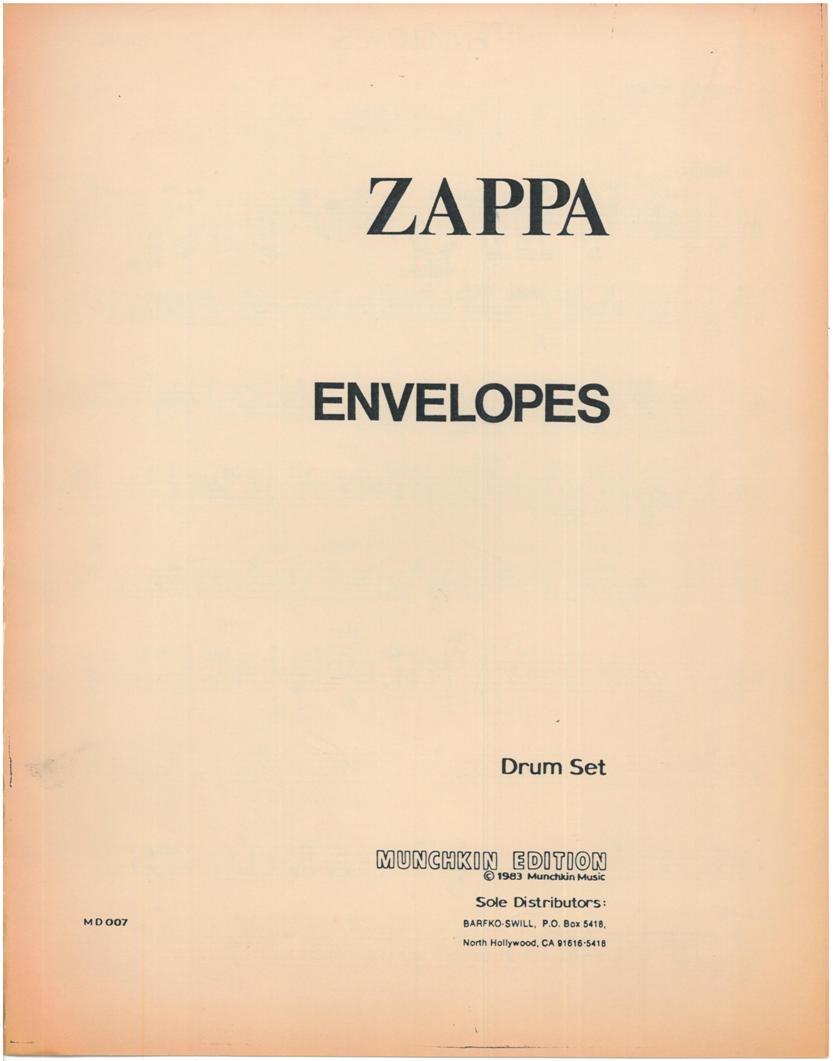
Shown here above are the frontpages of the drumset score of "Drowning witch" and "Envelopes". When he wrote for orchestras Zappa always scored out the drums and percussion part in detail,
and occasionally also when writing for his rock band. Since 1967 his band included both a drummer and a percussionist for most tours.
Ed Mann became the percussionist in Zappa's band during the fall tour of 1977 and stayed a member till the final 1988 tour. The percussion element in Zappa's
music is getting special attention in an article by Kyle Forsthoff and Michael Yonchak, "The mallets of invention.
A listening guide to Frank Zappa's percussionists" (Percussive notes, April 2024). About Ed Mann they write:
"Mann's skill set allowed Zappa to retain the functions of mallets and percussion in his live ensembles while simultaneously capitalizing on cutting-edge recording
and studio technologies, perfecting the techniques he'd previously used so successfully with Tripp and Underwood. Zappa could create the sense of having
an entire mallet section at his disposal by having Mann overdub mallet parts in the studio using combinations of marimba, vibraphone, xylophone, glockenspiel, and
chimes, in addition to various gongs and other percussion. Examples of these mallet choirs include the Baroque-flavored blues progression in the middle of "The
Central Scrutinizer", the angular interlude
of "Fembot in a wet T-shirt", the crystal line beauty of the interlude in "Packard goose", the pop sensibilities of "We are not alone",
"We're turning again", and "Sharleena", the operatic hard rock of "Teenage Prostitute", and the complex
polyrhythms of "Moggio", "Alien orifice", and the final section of "Sinister footwear II".
5. Envelopes (1982)
This is the rock-band version of "Envelopes (1983)", a modern atonal piece that was also orchestrated
for the L.S.O. recordings. The L.S.O. section from this study contains an example from this composition in its orchestral form,
reduced in the sense that I left out the instrumentation. There are many differences between these two versions.
An earlier version on the ZFT release "Odeon Hammersmith" goes different as well. At that point this composition had lyrics.
The 2020 ZFT release "The mothers 1970" shows that this composition already existed in 1970, with a studio recording being included.
Envelopes (1982), 0:00-0:19 (midi file).
Envelopes (1982), 0:00-0:19 (transcription).
The opening of the 1982 version begins with a figure played four times. It's being accompanied by Eb augm. (plus a high dissonant Bb at the beginning).
Ludwig is notating some bars
from this opening as diatonic, probably because of this theme returning later on in a different shape. At this point there are that many notes
altering that I consider about all of it atonal. Only the repeated opening bar might
be attributed to Eb minor, the variant with the augmented 7th (D natural). Once the melody of its main theme starts, Zappa is consistently applying
counterpoint, up to four-part counterpoint. It's kind of irregular, though repetitions of figures and similarities of motifs and their directions
can be detected.
Envelopes (1982), 2:17-2:44 (midi file).
Envelopes (1982), 2:17-2:44 (transcr./approximation).
This second example is the end of this piece, containing:
- Bars 1-2: the last two bars of a sequence, the three-part figure of bar 1 gets transposed down in the second bar, with some freedom.
- Bars 3-4: an irregular chromatic melody. It gets played that fast that I can't transcribe it other than by approximation.
- Bars 6-12: dark dissonant chords. Also here it's difficult to distinguish the notes involved. In the L.S.O. section you can find
the orchestral version of these bars with all notes forming huge cluster-like chords. The album version doesn't include that many notes,
but has additional descant chords by the keyboard played on top of the sustained chords.
- Bars 13-20: two melodies are played simultaneously. Because their rhythm is identical, a series of eighth notes, it sounds as a chord
progression rather than two-part counterpoint.
- Bar 21: a held chord rounds off this composition.
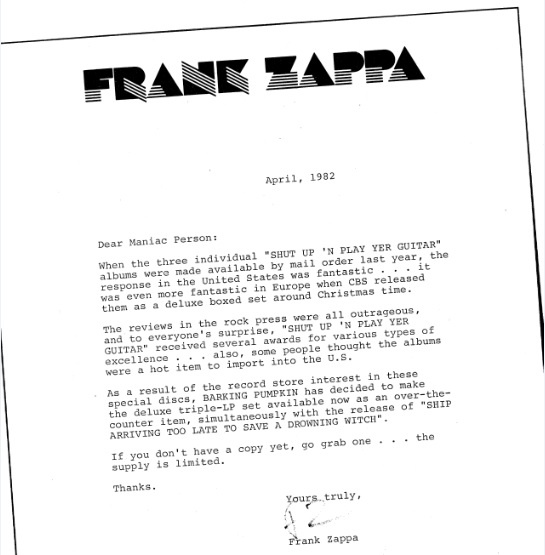
Frontside of the inner sleeve of the original Drowning witch album, with Zappa advertising for the Shut up 'n play yer guitar box (not included
in the CD booklet).
Shown here oblique, as also on the sleeve. The other side had the lyrics on it.
6. Teen-age prostitute
In January 2016 I was invited by Jos Zwaanenburg of the Amsterdam Conservatory to listen to a smaller Zappa concert during their
open house (January 23th). On the program were
among others "The Black Page" and "Teen-age prostitute", so I proposed to include an example from the sheet music they used for the latter song.
"Teen-age prostitute" doesn't have real themes. Rather it is made up of a series of phrases:
- 0:00 Intro with the guitars and bass hammering on the E.
Block with lyrics
- 0:05 Phrase 1 (She's only seventeen ...), played three times.
- 0:12 Phrase 2 (She's a teen-age prostitute).
Instrumental block
- 0:14 Phrase 3.
- 0:19 Phrase 4.
- 0:21 Phrase 5.
- 0:29 Phrase 6, played twice.
Block with lyrics returns
- 0:39 Phrase 1 (She ran away from home ...).
- 0:46 Phrase 2.
Instrumental block returns
- 0:49 Phrase 3.
- 0:53 Phrase 4.
- 0:55 Phrase 5.
- 1:02 Phrase 6, played twice.
Second block with lyrics
- 1:12 Phrase 7 (I have got a pimp ...).
Teen-age prostitute, section (midi file).
Teen-age prostitute, section (transcription).
First block with lyrics returns instrumentally, followed by another return of the instrumental block.
- 1:27 Phrase 1. The example above starts with the third repetition at 1:32.
The meter is standard 4/4 and most of the rhythm in this song is regular. The scales
on the other hand are only implied with altered/chromatic notes turning up all the time. It's one of the many examples
I'm calling multi-scale in the Burnt weeny sandwich section, with many scales getting touched upon only briefly.
In bar 1 of the example (the fourth bar of the phrase) the implied scale is C Mixolydian.
- 1:35 Phrase 2. The music is diatonic, but
the bass is moving too much to confirm a tonic.
- 1:38 Phrase 3. Bar 3 in 3/4 is chromatic. Bar 4 is in 4/4 again, with
the implied scales being C# Locrian during beats 1 and 2, and C Lydian during beats 3 and 4.
- 1:42 Phrase 4. An ultrafast descending chromatic line in 6/8. It turns up three times during this composition
with the details being different, so it's probably improvised along the idea of six times four 32nd notes and six eighth notes for the bass.
- 1:44 Phrase 5. The music returns to 4/4 again. The bass part features a descending chromatic line. In following order:
1) Bass G# with the F#m chord, implying G# Locrian or Phrygian.
2) Bass G natural with the F#m7 chord, implying G Lydian.
3) Bass G natural with the Ab chord, implying G Phrygian.
4) Bass F# with the Ab chord continuing. This is transitional with the combination not being a standard diatonic scale.
5) Bass F# with the G chord, implying F# Locrian or Phrygian.
6) Bass F natural with the G chord continuing, implying F Lydian.
- 1:51 Phrase 6. Rock music in E Locrian as the best fitting scale for the whole. Altered notes can turn up.
The keyboards are playing an upwards parallel movement of fourths, always before beat. The example above stops at 1:57.
First block with lyrics returns for the last time
- 2:01 Phrase 1 (The tiny little pants ...).
- 2:08 Coda.
- 2:19 Applause, fading out. At this point it comes out the best that various tracks were recorded live. At a few other instances
the audience can be heard lightly in the background.
- 2:40 End.
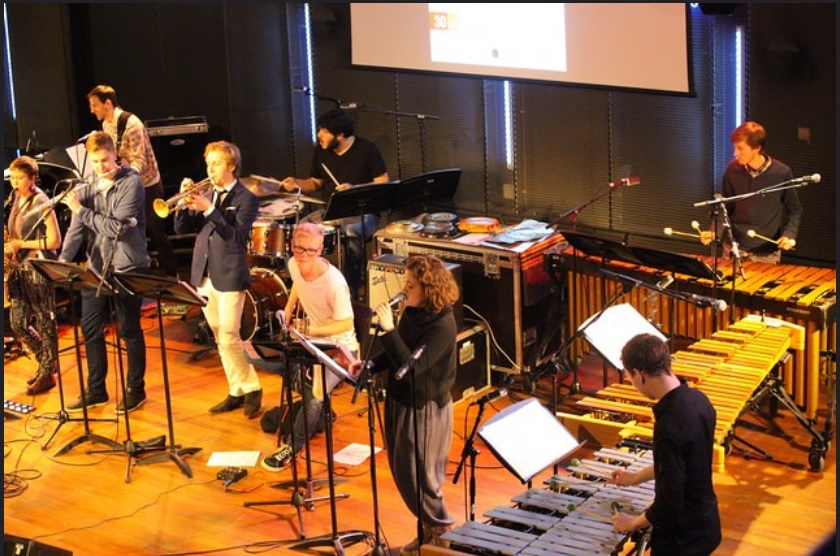
The above mentioned band performing Zappa's music at the Amsterdam Conservatory, 2016. Photo by Co Broerse.
Lisa's life story
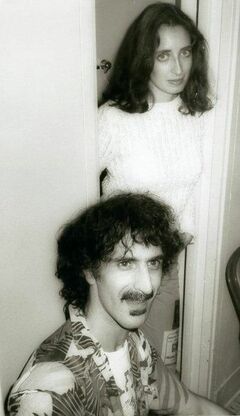 The lead singer from the previous song is Lisa Popeil. She gets a chance to tell her life story on stage during the 1981 tour, released on
"YCDTOSA Vol. VI" (the year 1980 in the booklet is a writing error). She's credited as being the "dramatic soprano" and for writing the words.
The example from below is a small outtake of four bars from the beginning.
To the right Lisa and Frank (downloaded from the Kill ugly radio site, the photographer doesn't get mentioned).
The lead singer from the previous song is Lisa Popeil. She gets a chance to tell her life story on stage during the 1981 tour, released on
"YCDTOSA Vol. VI" (the year 1980 in the booklet is a writing error). She's credited as being the "dramatic soprano" and for writing the words.
The example from below is a small outtake of four bars from the beginning.
To the right Lisa and Frank (downloaded from the Kill ugly radio site, the photographer doesn't get mentioned).
Lisa's life story, 0:06-0:11 (transcription).
Much of "Lisa's life story" is improvised. It's not really fit for transcribing nor for creating a midi file, based upon it. Some elements may have been rehearsed
and some others directed by Zappa on the spot. After a couple of seconds
the first block of this song begins, featuring a bass vamp, while the sustained glissando synthesizer notes from the beginning continue.
